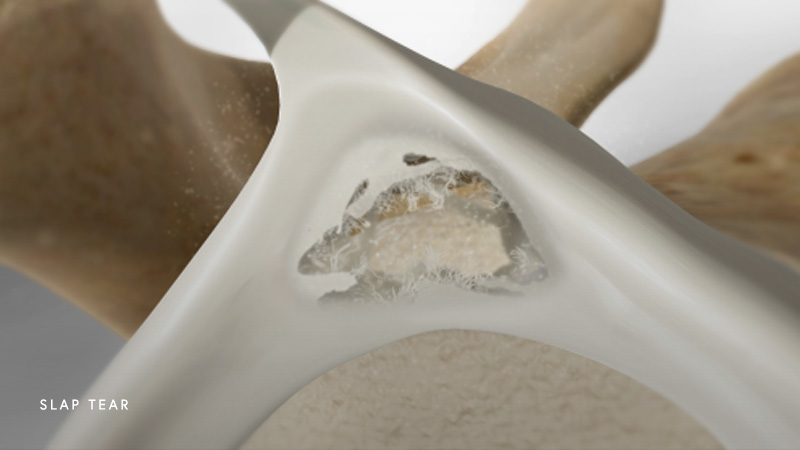SLAP Tear
A superior labral tear from anterior to posterior (SLAP Tear) occurs when there is an injury to the glenoid labrum (the cartilage) of the socket of the scapula. The labrum is essentially what holds the head/ball of the humerus in place in the socket of the scapula.
The shoulder is composed of the head of the humerus (upper arm bone) and the socket of the scapula (shoulder blade). There are two joints in the shoulder: the glenohumeral joint and the acromioclavicular joint. The glenohumeral joint is the ball-and-socket joint that is formed with the union of the head of the humerus and the socket of the scapula. The acromioclavicular joint is the junction of the clavicle (collarbone) with the scapula. SLAP tears occur in the glenohumeral joint in the glenoid labrum, an area that is lined with a layer of smooth cartilage.
There are two types of cartilage found in the shoulder. Articular cartilage is the smooth layer of soft tissue that blankets the ends of bones that attach to one another through muscles, tendons, and ligaments. This cartilage allows for the smooth and gliding motion of the bones within the shoulder joint. Meniscus cartilage found in the glenoid labrum lines the socket of the scapula and acts as a stabilizer of the glenohumeral joint.
A SLAP tear occurs when part of the ring of cartilage of the glenoid labrum is frayed or torn. Tears often lead to instability of the shoulder, lack of range of motion, and can even lead to a shoulder’s dislocation. The tear occurs in the superior (top) part of the glenoid labrum where the bicep tendon is attached.The tear can occur in either the front or back of the glenoid labrum. In some cases, the bicep tendon may also be injured as a result of a SLAP tear. SLAP tears are classified by types 1-10 based on the level of severity.

SLAP tears can develop over time with age. For individuals 40 years of age or older, SLAP tears are considered a normal part of the aging process. However, it is most common for SLAP tears to occur as a result of a major injury or major physical trauma. Falling on an outstretched arm, car accidents, dislocation of the shoulder, and quickly/aggressively moving the arm while it is above the shoulder can all lead to SLAP tears. Repetitive shoulder motions in athletes who participate in sports that involve throwing are also likely to get SLAP tears.
Symptoms vary depending on the severity of the SLAP tear and its classification. More often than not, those with any form of SLAP tear are likely to experience symptoms including:
- Shoulder locking
- Shoulder popping
- Grinding of the shoulder joint
- Pain when moving the arm
- Pain when lifting the arm above the head
- Pain when reaching behind the back
- Reduced range of motion
- Weakness in the shoulder
During the physical exam, the physician will apply pressure to the affected area to see if there is any pain, tenderness, or disformity. The physician will also move the arm and test range of motion to see if there is any stiffness or pain associated with the movement. If a diagnosis and classification of the tear cannot be rendered by a physical exam alone, imaging tests will be ordered. XRays will determine whether there has been a break or fracture in the head of the humerus or scapula. MRIs and CT (CAT) scans are most commonly ordered given their ability to produce images of the soft tissues within the shoulder joint. Medical history is also taken into account.
Treatments for SLAP tears are entirely dependent on the type of classification of the tear. More often than not, nonsurgical treatments including NSAID medications, physical therapy, rest, immobilization, and icing will likely alleviate symptoms and ultimately heal the injury. If the SLAP tear is severe, surgery is often recommended.
Surgical procedures for SLAP tears often utilize the arthroscopy method. Arthroscopic procedures involve a small incision in the affected area where a small camera and surgical tools are inserted. SLAP tear surgical repairs include removing the torn portion of the labrum, trimming the tear, stitching the tear back together, or cutting out the bicep tendon attachment to the shoulder joint. Rehabilitation and recovery typically takes a total of 20 weeks or more prior to surgery.
If you or a loved one are currently experiencing any symptoms of a SLAP tear, or have been diagnosed and require treatment, reach out to the experts at the Center for Orthopaedic Specialists. Contact us today!




 / 50 Reviews
/ 50 Reviews